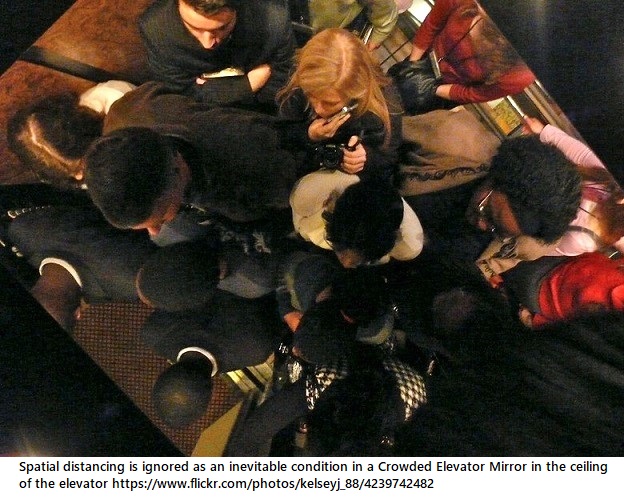Spatial distancing or separation is very important factor that
determines the relationships we allow to flourish and sustain in a Space. Other factors
include our capacity of sensorial perception, psychological and
biological needs. Spatial distancing is determined by the reach tools that we can exploit for a situation. Strength of voice transmission determines how one should be heard or not. In many cultures the gender separation is the reach determinant. There are public spaces where abstract barricades indicate the desired separation. Queues get formed as the visual connection to the destination and shaped by the local territorial conditions. In large public spaces, the occupation is related as a balanced reach between the exit and the destined focus.
Hall (1959) has stipulated that spatial separation also serves an
expansive function. He made a study of the Spatial relations that
seem appropriate to various kinds of interactions. They vary with
intimacy, and depend on the possibility of eye contact. These distances vary
with the culture.
One can easily distinguish strangers from friends in an airport lounge.
Strangers will keep a distance, taking alternate seats wherever possible.
Friends tend to form clots, and families even pile one on the top of
another. Total strangers will comfortably seat themselves only inches
apart if the seats are back to back, but friends and the members of the
family never arrange themselves in this way. Eye contact invites
interaction and so is sought to the degree that intimacy already exists.
(Hall E. T. 1959 The silent language).
Hall argues that there are spatial zones appropriate to various types
of interactions. Though distances through virtual communication
technology mediated interactions are likely to be different. Hall has
also shown the cultural variations that South American needs much
closer distance for impersonal information, than a North American
desire or is accustomed to.
Very close 75 to 150mm Soft whisper, top secret
Close 200 to 300mm Audible whispers, very confidential
Near 300 to 500mm Soft voice, confidential
Neutral 500 to 900mm Soft voice, low volume, personal
subject matter
Neutral 1300 to 1500mm Full voice, impersonal information
Public 1700 to 2500mm Slightly over-loud, information for
others to hear
Across room 2500 to 6000mm Loud voice, talking to a group
Hailing privately 6000 to 7500 mm Indoors, Loud voice departures
Impersonal discussion, take place at 1200 to 1500 mm; cross the
inner boundary of this zone and one’s interlocutor will retreat; cross
the outer boundary and will advance or subtly change the manner in
which to behave adopting the pattern appropriate to the new
distance. One can move from impersonal discussion to personal
matter by reducing the distance, or to a non personal information
exchange by increasing the distance. TV anchors do the distance
trick on their show. For an intimate question the anchor pushes
forward own body (Larry King of CNN), but as soon as the question
sinks in with the guest, the anchor withdraws not just to the nominal
position but little further backward. These distancing movements
allow the guest to deliver the answer more objectively and the
camera frames the guest alone for such a ‘heroic effort’. However,
a host may intimidate the guest by doing exactly opposite of this.











No comments:
Post a Comment